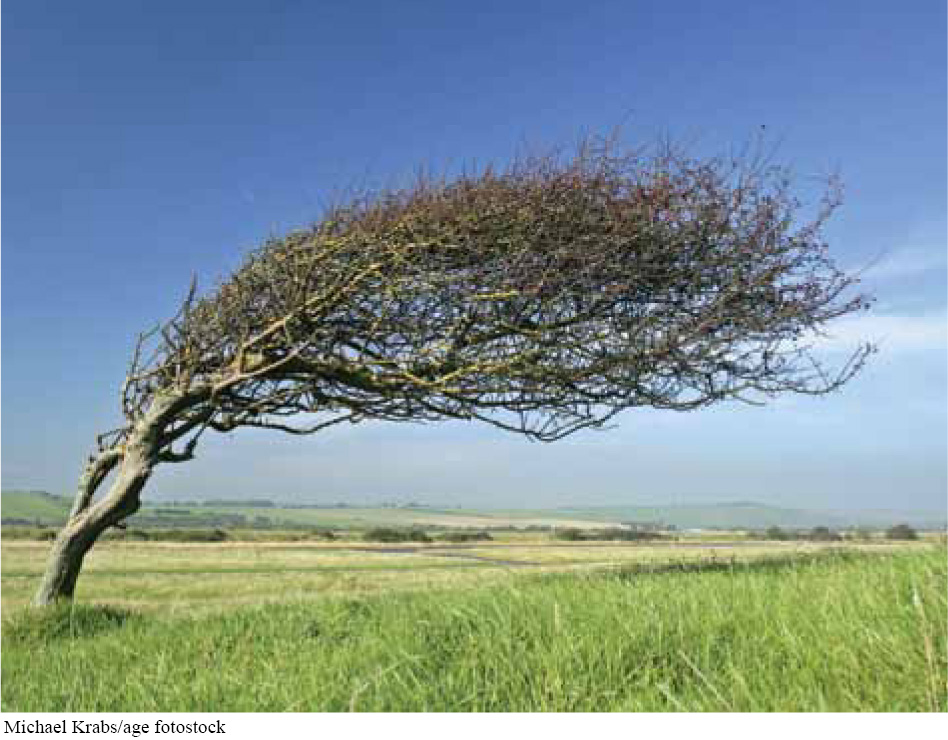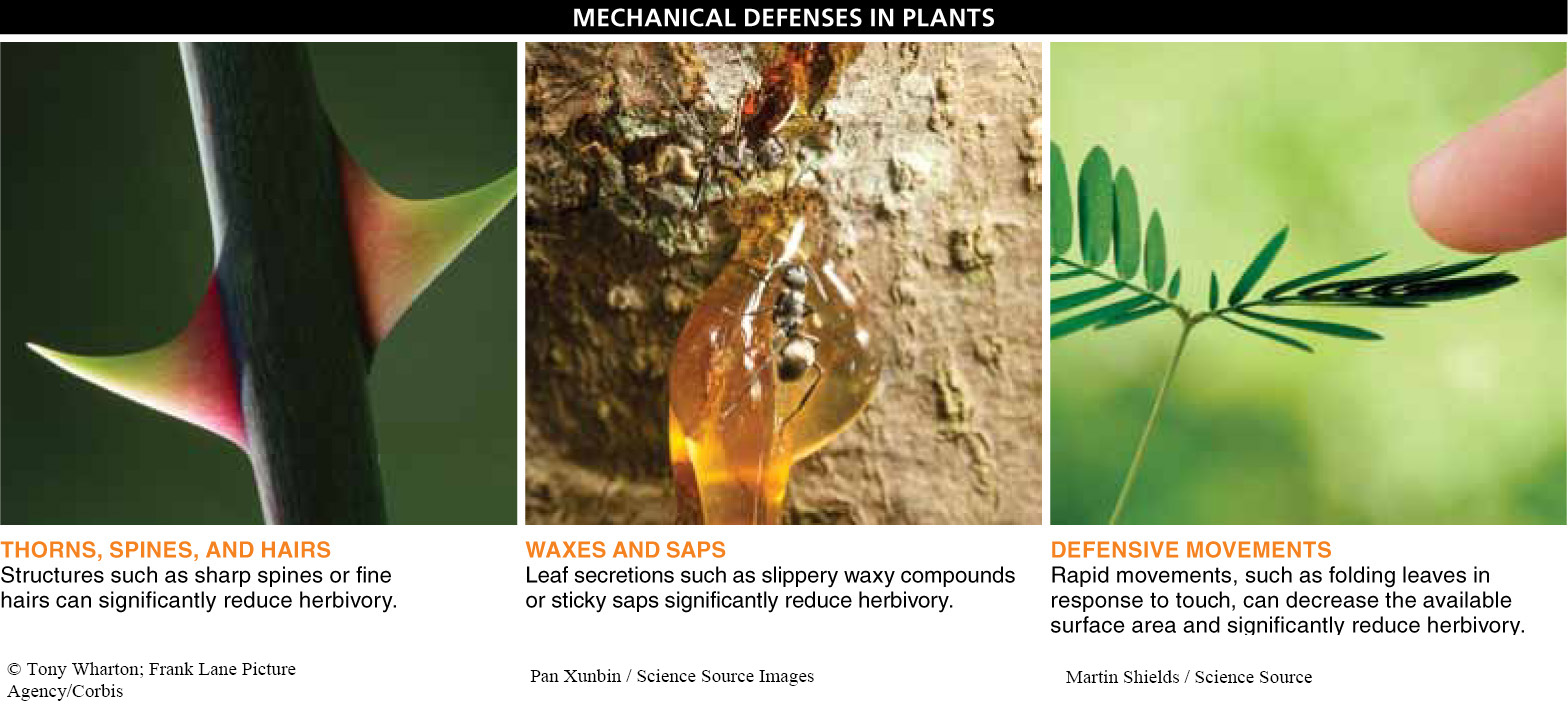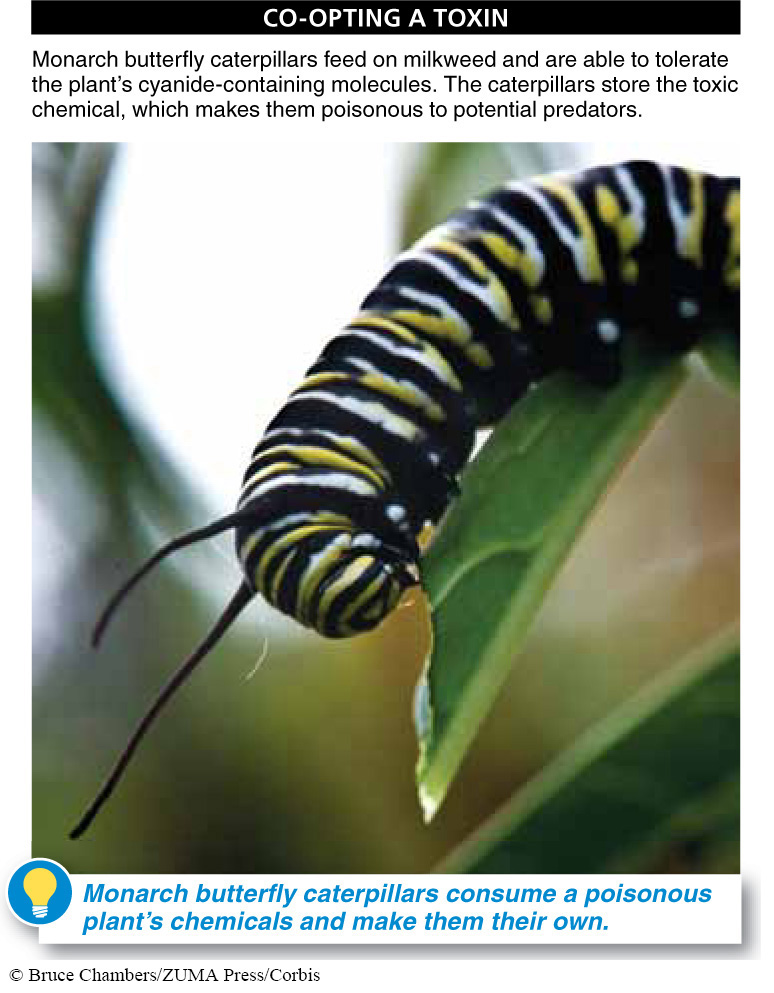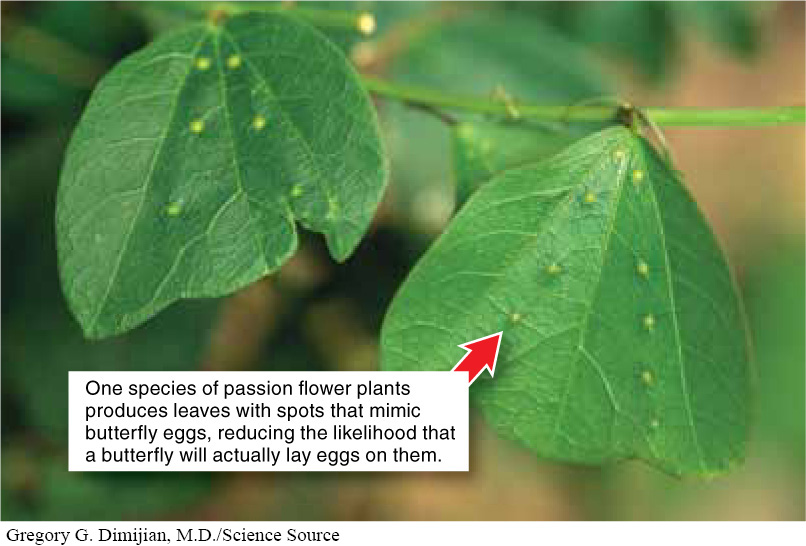
Plants are under almost constant attack. From microbes to fungi, animals, and even other plants, organisms make varied and persistent efforts to access the valuable resources in plants. In some cases, the attackers can kill the plant outright. The soil fungus Macrophomina phaseoline, for example, causes something called charcoal rot that can harm the roots and lower stems—
Plants, rooted in the ground, are unable to employ many of the strategies used by animals and other organisms for resisting predation and responding to inhospitable environments. Nevertheless, plants have evolved to fight back. They have numerous defenses that can help them reduce the competitive and predatory “tax” they constantly face. These defenses fall into four general categories: mechanical defenses, chemical defenses, mimicry or camouflage, and enlisting help from elsewhere.
Mechanical Defenses Several types of plant defenses take the form of physical structures or movements (FIGURE 19-1).

Thorns, spines, and hairs. If you’ve ever tried to pick blackberries or raspberries, you probably encountered sharp prickles on the stems. And while these may have been only a nuisance to you, they can be enough of a deterrent to many herbivores—
Waxes and saps. Producing leaves covered with waxy compounds can also reduce herbivory. Researchers have documented, for example, that beetles spend more time slipping and falling off waxy leaves—
Defensive (and offensive) movements. The Venus flytrap is the most dramatic example of a plant making use of rapid movement. As we will see in Section 22-
Chemical Defenses One of the most common methods that plants use to fight herbivory is the production of chemical defenses. These are chemical compounds (sometimes called “secondary compounds”) that make the plant toxic, reduce palatability, or reduce its digestibility so as to lessen its value to the herbivore.
765

One common strategy, used by more than 3,000 species of plants, is to produce cyanide-
As the consequence of a sort of evolutionary arms race between plants and herbivores, the individuals of some herbivore species have the ability to eat toxic secondary compounds without suffering ill effects. Monarch butterfly caterpillars, for example, can safely consume the toxic cardiac glycosides produced by milkweed plants that kill most insects and induce heart attacks in vertebrates (FIGURE 19-2). Moreover, the monarchs store the toxic chemicals within their cell vacuoles and then become poisonous to their predators.
Other common toxins produced by plants to reduce herbivory include the neurotoxic chemicals in hemlock—
Many plants secrete toxic chemicals from their roots that block the germination of seeds and reduce the growth of nearby plants, conferring a competitive advantage. For example, because their roots secrete toxic chemicals, black walnut trees are able to prevent most plants from growing underneath them.
766
Can humans benefit from plants’ attempts to avoid being eaten?
Beneficial Effects of Secondary Compounds Humans have long made use of some of the “defensive” compounds produced in or by plants.
Spices. Spicy foods, such as mustard, usually get their flavor from secondary plant compounds that may make the plant toxic or unpalatable to an insect but are not toxic to humans (see Section 22-


Medicines. Many of our medicines come from compounds isolated from plants. After all, a chemical that disrupts a microbe’s metabolism can have its effect whether the microbe is on a plant or inside a human. These medicines include taxol, a compound with anti-
Mimicry and Camouflage Another way that plants resist predation is through mimicry and camouflage. The Heliconius group of butterflies includes a large number of species that lay their eggs on the leaves of passion flower plants. On hatching, the insects begin eating the plant, often causing significant damage. By producing leaves that appear to be already covered with butterfly eggs, one species of passion flower reduces the likelihood that butterflies will lay eggs on its leaves (FIGURE 19-4). Females will not lay their eggs on a leaf that already has Heliconius eggs, because the first batch of eggs would hatch sooner and the larvae would eat the leaves, destroying the eggs laid by the second butterfly.
Enlisting Other Organisms for “Security” Researchers have even discovered mutualistic situations in which plants seem to outsource some of their defenses to another species. Acacia plants produce a sweet nectar that attracts ants. The ants hollow out thorns in the plants and live inside them. In exchange for their “room and board,” the ants quickly and aggressively attack leaf-
In the following sections, we further explore the wide variety of physical and biochemical methods by which plants reduce the impact of environmental challenges.
TAKE-HOME MESSAGE 19.1
Rooted in the ground, plants are targets for predators and pathogens. They actively resist these challenges by several methods, including mechanical and chemical methods that make them distasteful, poisonous, or difficult to consume.
How does the Monarch butterfly caterpillar turn a plant defense into a defense of its own?
Milkweed produces cyanogenic glycosides to kill insects eating their leaves. Monarch butterfly caterpillars can eat these leaves without being poisoned. They then retain these chemicals within their cells and become poisonous to animals that eat them.
767